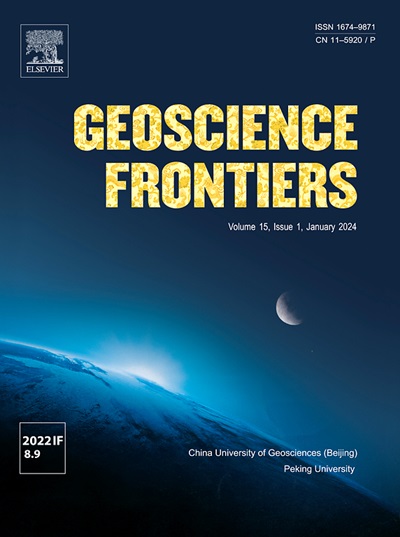库页岛东北部达吉斯基热矿泉的地质甲烷排放:2024年考察和遥感数据
IF 8.9
1区 地球科学
Q1 GEOSCIENCES, MULTIDISCIPLINARY
引用次数: 0
摘要
本文在野外研究与遥感资料对比的基础上,讨论了海洋和陆架过渡带气体地球化学参数的紧迫问题。本文介绍了Daginsky气热液系统复杂气体地球化学研究的结果,并对研究区甲烷排放进行了评价。Daginsky气热液系统位于库页岛东北海岸,是一个独特的对象,因为许多因素的组合:从靠近鄂霍次克海和地质结构的地带性,到深层和地表过程的相互作用,表现为生物和热成因甲烷的存在,以及地幔氦。库页岛东北陆架的构造断裂和含油气构造决定了天然气的流动方向,有利于天然气向地表运移,对温泉的气相形成有重要贡献。主要气体是高达90%的甲烷,甲烷的同系物(包括戊烷)已被确定,并且分离出高浓度的氦和氢,无论是溶解的还是在气泡的自由气体中,也被注意到。所进行的同位素研究使我们能够谈论这种气体的复杂成因。δ13C同位素组成范围为- 49.4‰~ - 60.2‰,以生物成因甲烷为主,并伴有热成因甲烷。地幔氦的存在也证实了这一点。Daginsky地区向大气的甲烷流量为963757.5 mol/(km2·d),约15.4 t/(km2·年),表明该地区对区域和全球碳循环的重要性。甲烷排放的动态可能因季节波动和地质活动等各种因素而异,这进一步使对该区域过程的理解复杂化。本文章由计算机程序翻译,如有差异,请以英文原文为准。

Geologic methane emissions from the Daginsky thermo-mineral springs in the northeast of Sakhalin Island: 2024 expedition and remote sensing data
The paper deals with the urgent problem of gas-geochemical parameters in the seas and shelf transit zones based on a comparison of field studies and remote sensing data. The results of complex gas-geochemical studies of the Daginsky gas-hydrothermal system are presented, as well as an assessment of methane emissions from the studied area. The Daginsky gas-hydrothermal system is located on the northeastern coast of Sakhalin Island, and is a unique object due to a combination of a number of factors: from zonality due to the proximity of the Okhotsk Sea and the geological structure, to the interaction of deep and surface processes manifested in the presence of biogenic and thermogenic methane, as well as mantle helium. Tectonic faults and oil and gas bearing structures of the northeastern shelf of Sakhalin, which determine the direction of natural gas flows and facilitate its migration to the surface, make a significant contribution to the gas appearance of thermal springs. The main gas is methane up to 90%, homologues of methane up to and including pentane have been established, and isolated high concentrations of helium and hydrogen, both dissolved and in the free gas of bubbles, have also been noted. The conducted isotope studies allow to speak about the complex genesis of the gas. δ13C isotopic composition, ranging from −49.4‰ to −60.2‰ shows the dominance of biogenic methane with an admixture of thermogenic component. This is also confirmed by the presence of a fraction of mantle helium. The flow of methane into the atmosphere from the Daginsky area is 963757.5 mol/(km2·day), or about 15.4 t/(km2·year), which indicates the importance of this region for the regional and global carbon cycle. The dynamics of methane emissions can vary depending on various factors, such as seasonal fluctuations and geological activity, which further complicates the understanding of processes in the region.
求助全文
通过发布文献求助,成功后即可免费获取论文全文。
去求助
来源期刊

Geoscience frontiers
Earth and Planetary Sciences-General Earth and Planetary Sciences
CiteScore
17.80
自引率
3.40%
发文量
147
审稿时长
35 days
期刊介绍:
Geoscience Frontiers (GSF) is the Journal of China University of Geosciences (Beijing) and Peking University. It publishes peer-reviewed research articles and reviews in interdisciplinary fields of Earth and Planetary Sciences. GSF covers various research areas including petrology and geochemistry, lithospheric architecture and mantle dynamics, global tectonics, economic geology and fuel exploration, geophysics, stratigraphy and paleontology, environmental and engineering geology, astrogeology, and the nexus of resources-energy-emissions-climate under Sustainable Development Goals. The journal aims to bridge innovative, provocative, and challenging concepts and models in these fields, providing insights on correlations and evolution.
 求助内容:
求助内容: 应助结果提醒方式:
应助结果提醒方式:


